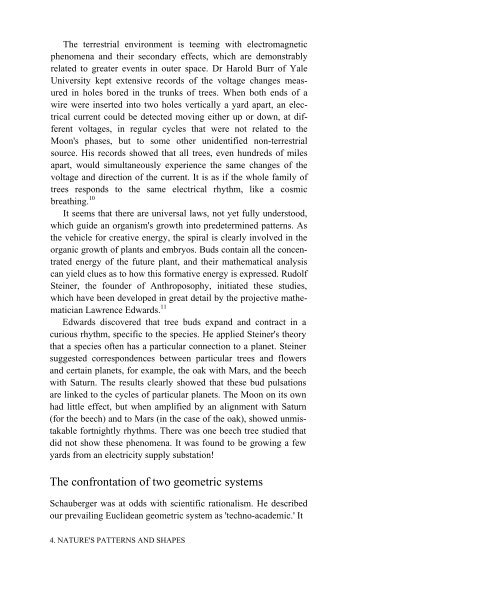levitational current - Free Energy
levitational current - Free Energy
levitational current - Free Energy
Create successful ePaper yourself
Turn your PDF publications into a flip-book with our unique Google optimized e-Paper software.
The terrestrial environment is teeming with electromagnetic<br />
phenomena and their secondary effects, which are demonstrably<br />
related to greater events in outer space. Dr Harold Burr of Yale<br />
University kept extensive records of the voltage changes measured<br />
in holes bored in the trunks of trees. When both ends of a<br />
wire were inserted into two holes vertically a yard apart, an electrical<br />
<strong>current</strong> could be detected moving either up or down, at different<br />
voltages, in regular cycles that were not related to the<br />
Moon's phases, but to some other unidentified non-terrestrial<br />
source. His records showed that all trees, even hundreds of miles<br />
apart, would simultaneously experience the same changes of the<br />
voltage and direction of the <strong>current</strong>. It is as if the whole family of<br />
trees responds to the same electrical rhythm, like a cosmic<br />
breathing. 10<br />
It seems that there are universal laws, not yet fully understood,<br />
which guide an organism's growth into predetermined patterns. As<br />
the vehicle for creative energy, the spiral is clearly involved in the<br />
organic growth of plants and embryos. Buds contain all the concentrated<br />
energy of the future plant, and their mathematical analysis<br />
can yield clues as to how this formative energy is expressed. Rudolf<br />
Steiner, the founder of Anthroposophy, initiated these studies,<br />
which have been developed in great detail by the projective mathematician<br />
Lawrence Edwards. 11<br />
Edwards discovered that tree buds expand and contract in a<br />
curious rhythm, specific to the species. He applied Steiner's theory<br />
that a species often has a particular connection to a planet. Steiner<br />
suggested correspondences between particular trees and flowers<br />
and certain planets, for example, the oak with Mars, and the beech<br />
with Saturn. The results clearly showed that these bud pulsations<br />
are linked to the cycles of particular planets. The Moon on its own<br />
had little effect, but when amplified by an alignment with Saturn<br />
(for the beech) and to Mars (in the case of the oak), showed unmistakable<br />
fortnightly rhythms. There was one beech tree studied that<br />
did not show these phenomena. It was found to be growing a few<br />
yards from an electricity supply substation!<br />
The confrontation of two geometric systems<br />
Schauberger was at odds with scientific rationalism. He described<br />
our prevailing Euclidean geometric system as 'techno-academic.' It<br />
4. NATURE'S PATTERNS AND SHAPES








![The Big Lie 9-11 and Government Complicity in Mass Murder [PDF]](https://img.yumpu.com/50957077/1/190x245/the-big-lie-9-11-and-government-complicity-in-mass-murder-pdf.jpg?quality=85)








